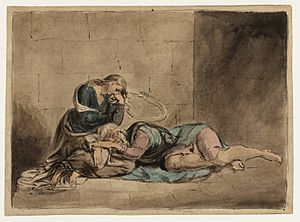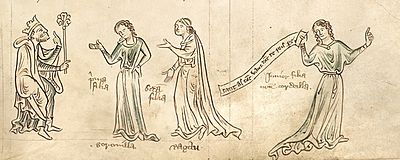Leir of Britain facts for kids
Leir was a legendary king of the ancient Britons. His story was first told by Geoffrey of Monmouth in his 12th-century book, History of the Kings of Britain. According to Geoffrey, Leir ruled around the 8th century BC, which was about the time the city of Rome was founded. Later, the famous writer William Shakespeare changed and retold Leir's story in his play King Lear.
Contents
What's in a Name?
Geoffrey of Monmouth said that Leir was the person who gave his name to the city of Leicester in England. In old English, Leicester was called Ligoraceastre. The names Leir, Lerion, and Ligora all come from an old name for the River Soar, which flows through Leicester.
The Legend of King Leir
Leir's Time as King
The story of King Leir first appeared in Geoffrey of Monmouth's History of the Kings of Britain. In this book, Leir was part of a royal family that started with Brutus of Troy. Leir became king after his father, Bladud, died trying to fly with homemade wings. Leir ruled for 60 years, which was a very long time for a king in Geoffrey's stories. Geoffrey also claimed that Leir founded the city of Leicester.
Dividing the Kingdom
King Leir had no sons, only three daughters: Goneril, Regan, and Cordelia. As he grew old and thought about his death, he decided to divide his kingdom among them.
Goneril and Regan were very good at flattering their father. Following advice from his nobles, Leir married them off to the Dukes of Albany and Cornwall. Cordelia, however, was Leir's favorite daughter, but she refused to flatter him. She felt she shouldn't have to make special promises of her love. Because of this, Leir gave her no land to rule.
Later, King Aganippus of the Franks (from what is now France) wanted to marry Cordelia. He married her even though Leir refused to give her a dowry (money or property given by a bride's family).
Leir then gave Goneril and Regan half of his kingdom, planning to give them the rest when he died. But his sons-in-law rebelled and took control of the entire kingdom. Goneril's husband, Duke Maglaurus, first allowed Leir to live with 60 knights. However, Goneril cut this number in half after two years. Leir then went to Regan, who reduced his group to only five men. When he returned to Goneril and begged for help, he was left with just one knight for protection.
Leir Gets His Throne Back
At this point, Leir was afraid of both his older daughters. He fled to France and sent a message to Cordelia. She welcomed him warmly, gave him new royal clothes, and provided him with many loyal followers. King Aganippus officially welcomed Leir and made him a ruler in France. The French nobles promised to help Leir get his kingdom back.
Leir, Cordelia, and her husband then invaded Britain. They successfully defeated Leir's other daughters and sons-in-law. Leir ruled for three more years and then passed away. Cordelia became queen after him. She buried her father in a special underground shrine dedicated to the god Janus. This shrine was said to be under the River Soar near Leicester, possibly where the city's Jewry Wall is today. People held an annual celebration nearby to honor him.
| Family tree of the House of Brutus of Troy | ||||||||||||||||||||||||||||||||||||||||||||||||||||||||||||||||||||||||||||||||||||||||||||||||||||||||||||||||||||||||||||||||||||||||||||||||||||||||||||||||||||||||||||||||||||||||||||||||||||||||||||||||||||||||||||||||||||||||||||||||||||||||||||||||||||||||||||||||||||||||||||||||||||||||||||||||||||||||||||||||||||||||||||||||||||||||||||||||||||||||||||||||||||||||||||||||||||||||||||||||||||||||||||||||||||||||||||||||||||||||||||||||||||||||||||||||||||||||||||||||||||||||||||||||||||||||||||||||||||||||||||||||||||||||||||||||||||||||||||||||||||||||||||||||||||||||||||||||||||||||||||||||||||||||||||||||||||||||||||||||||||||||||||||||||||||
|---|---|---|---|---|---|---|---|---|---|---|---|---|---|---|---|---|---|---|---|---|---|---|---|---|---|---|---|---|---|---|---|---|---|---|---|---|---|---|---|---|---|---|---|---|---|---|---|---|---|---|---|---|---|---|---|---|---|---|---|---|---|---|---|---|---|---|---|---|---|---|---|---|---|---|---|---|---|---|---|---|---|---|---|---|---|---|---|---|---|---|---|---|---|---|---|---|---|---|---|---|---|---|---|---|---|---|---|---|---|---|---|---|---|---|---|---|---|---|---|---|---|---|---|---|---|---|---|---|---|---|---|---|---|---|---|---|---|---|---|---|---|---|---|---|---|---|---|---|---|---|---|---|---|---|---|---|---|---|---|---|---|---|---|---|---|---|---|---|---|---|---|---|---|---|---|---|---|---|---|---|---|---|---|---|---|---|---|---|---|---|---|---|---|---|---|---|---|---|---|---|---|---|---|---|---|---|---|---|---|---|---|---|---|---|---|---|---|---|---|---|---|---|---|---|---|---|---|---|---|---|---|---|---|---|---|---|---|---|---|---|---|---|---|---|---|---|---|---|---|---|---|---|---|---|---|---|---|---|---|---|---|---|---|---|---|---|---|---|---|---|---|---|---|---|---|---|---|---|---|---|---|---|---|---|---|---|---|---|---|---|---|---|---|---|---|---|---|---|---|---|---|---|---|---|---|---|---|---|---|---|---|---|---|---|---|---|---|---|---|---|---|---|---|---|---|---|---|---|---|---|---|---|---|---|---|---|---|---|---|---|---|---|---|---|---|---|---|---|---|---|---|---|---|---|---|---|---|---|---|---|---|---|---|---|---|---|---|---|---|---|---|---|---|---|---|---|---|---|---|---|---|---|---|---|---|---|---|---|---|---|---|---|---|---|---|---|---|---|---|---|---|---|---|---|---|---|---|---|---|---|---|---|---|---|---|---|---|---|---|---|---|---|---|---|---|---|---|---|---|---|---|---|---|---|---|---|---|---|---|---|---|---|---|---|---|---|---|---|---|---|---|---|---|---|---|---|---|---|---|---|---|---|---|---|---|---|---|---|---|---|---|---|---|---|---|---|---|---|---|---|---|---|---|---|---|---|---|---|---|---|---|---|---|---|---|---|---|---|---|---|---|---|---|---|---|---|---|---|---|---|---|---|---|---|---|---|---|---|---|---|---|---|---|---|---|---|---|---|---|---|---|---|---|---|---|---|---|---|---|---|---|---|---|---|---|---|---|---|---|---|---|---|---|---|---|---|---|---|---|---|---|---|---|---|---|---|---|---|---|---|---|---|---|---|---|---|---|---|---|---|---|---|---|---|---|---|---|---|---|---|---|---|---|---|---|---|---|---|---|---|---|---|---|---|---|---|---|---|---|---|---|---|---|---|---|---|---|---|---|---|---|---|---|---|---|---|---|---|---|---|---|---|---|---|---|---|---|---|---|---|---|---|---|---|---|---|---|---|---|---|---|---|---|---|---|---|---|---|---|---|---|---|
|
||||||||||||||||||||||||||||||||||||||||||||||||||||||||||||||||||||||||||||||||||||||||||||||||||||||||||||||||||||||||||||||||||||||||||||||||||||||||||||||||||||||||||||||||||||||||||||||||||||||||||||||||||||||||||||||||||||||||||||||||||||||||||||||||||||||||||||||||||||||||||||||||||||||||||||||||||||||||||||||||||||||||||||||||||||||||||||||||||||||||||||||||||||||||||||||||||||||||||||||||||||||||||||||||||||||||||||||||||||||||||||||||||||||||||||||||||||||||||||||||||||||||||||||||||||||||||||||||||||||||||||||||||||||||||||||||||||||||||||||||||||||||||||||||||||||||||||||||||||||||||||||||||||||||||||||||||||||||||||||||||||||||||||||||||||||

Leir's Story in Culture
The story of King Leir was made into a play during the Elizabethan era (the time of Queen Elizabeth I). This play, called King Leir, was first published in 1605. It was a comedy that followed Geoffrey's story and ended happily with Leir getting his power back. This play was an important story before Shakespeare wrote his famous tragedy King Lear. Leir's story also appears in other old works, like John Higgins's Mirror for Magistrates and Edmund Spenser's The Faerie Queene.


